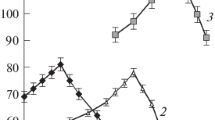Abstract
We used the sessile drop method to study the temperature dependences of the density and surface tension of tin and liquid glass. We have studied the effect of the composition of the gas phase on the surface tension of the glass. We used the method of adjoining drops to determine the temperature dependence of the interfacial tension at the glass horbar; tin melt boundary. We have studied the effect of silicon, aluminum, iron, nickel, and manganese on the interfacial tension in the glass ― tin system. We have shown that in this system, these additives are not interface-active.
Similar content being viewed by others
REFERENCES
V. N. Eremenko (ed.), Physical Chemistry of Inorganic Materials, Vol.3, Physical Chemistry of Reaction between Liquid Metals and Materials [in Russian], Nauk. Dumka, Kiev (1988).
Yu. M. Ivashchenko and V. N. Eremenko, Principles of Precision Measurement of Surface Energy of Melts by the Sessile Drop Method [in Ukrainian], Nauk. Dumka, Kiev (1972).
Yu. V. Naidich and V. N. Eremenko, “Large drop" method for determining surface tension and density of molten metals at high temperatures,” Fizika Metallov i Metallovedenie, 11, No. 6, 883–888 (1961).
V. I. Nizhenko and Yu. I. Smirnov, “Apparatus for determining surface properties and density of melts with semiautomatic delivery of samples to the heating zone,” in: Research Methods and Properties of Interfaces between Contacting Phases [in Russian], Nauk. Dumka, Kiev (1977), pp. 33–51.
V. I. Nizhenko, “Experimental estimate of the free surface energy of solids,” in: Surface Phenomena in Melts [in Russian], Nauk. Dumka, Kiev (1968), pp. 118–126.
V. I. Nizhenko and Yu. I. Smirnov, “Adjoining drop method for studying interfacial properties at the interface between two melts,” Adgeziya Rasplavov i Paika Materialov, No. 2, 6–9 (1977).
Yu. N. Ivashchenko, B. B. Bogatyrenko, and V. N. Eremenko, “Calculation of the surface tension of a liquid from sessile drop sizes,” in: Surface Phenomena in Melts and Powder Metallurgy Processes [in Russian], Izdat. Akad. Nauk Ukr. SSR, Kiev (1963), pp. 391–417.
Yu. V. Naidich, Contact Phenomena in Metallic Melts [in Russian], Nauk. Dumka, Kiev (1972).
S. I. Popel', V. V. Pavlov, V. N. Kozhurkov, and V. P. Nemchenko, “Some topics in theoretical and experimental study of surface phenomena,” in: Surface Phenomena in Melts [in Russian], Nauk. Dumka, Kiev (1977), pp. 125–163.
V. I. Nizhenko, “Density of liquid metals and its temperature dependence,” in: Research Methods and Properties of Interfaces between Contacting Phases [in Russian], Nauk. Dumka, Kiev (1968), pp. 86–105.
V. I. Nizhenko and L. I. Floka, Surface Tension of Liquid Metals and Alloys: Handbook [in Russian], Metallurgiya, Moscow (1981).
N. K. Adam, The Physics and Chemistry of Surfaces [Russian translation], Gostekhizdat, Moscow (1947).
V. V. Pavlov, S. I. Popel', and O. A. Esin, “Dependence of the interfacial tension on composition and temperature,” in: Surface Phenomena in Melts and Solid Phases Originating from Them [in Russian], Kabardino-Balkar. Kn. Izdat., Nal'chik (1965), pp. 136–141.
A. W. Adamson, Physical Chemistry of Surfaces [Russian translation], Mir, Moscow (1979).
V. E. Listovnichii and V. M. Sergeenkova, “Study of diffusion processes in a glass - liquid metal system,” in: The Physical Chemistry of Condensed Phases, Ultrahard Materials, and Their Interfaces [in Russian], Nauk. Dumka, Kiev (1975), pp. 209–218.
V. N. Eremenko, V. M. Sergienkova, V. E. Listovnichii, and O. V. Murzin, “Mass transport of tin from its melt to glass under an argon atmosphere with PO = 10- 16-10- 18 atm,” Dop. Akad. Nauk UkrRSR, Ser. A, No. 6, 560–564 (1975).
V. N. Eremenko, V. E. Listovnichii, and V. M. Sergienkova, “Mass transport of tin from its melt to glass in hydrogen medium,” Dop. Akad. Nauk UkrRSR, Ser. A, No. 7, 655–659 (1975).
V. N. Eremenko, V. M. Sergeenkova, and V. E. Listovnichii, “Contact interaction and mass transport in the tin melt - glass system,” in: The Physics of Interfacial Phenomena [in Russian], Izdat. Kabardino-Balkar. Univ., Nalchik (1976), pp. 94–106.
N. L. Pokrovskii and N. D. Galanina, “Properties of metallic solutions. IV. Surface tension of tin and tin- sodium melts,” Zhurn. Fiz. Khim., 23, No. 3, 324–331 (1949).
L. Goumiri and I. C. Joud, “Auger electron spectroscopy study of aluminium - tin liquid system,” Acta Metall., 30, No. 7, 1397–1405 (1982).
J. A. Champion, B. I. Keene, and J. M. Sillwood, “Wetting of aluminium oxide by molten aluminium and other metals,” J. Mater. Sci., 4, No. 1, 39–49 (1969).
R. D. Carnahan, T. L. Jonston, and C. H. Li, “Some observations of the wetting of Al2O3 by aluminium,” J. Amer. Ceram. Soc., 41, No. 9, 13–16 (1958).
O. A. Esin and P. V. Gel'd, The Physical Chemistry of Pyrometallurgical Processes [in Russian], Metallurgiya, Moscow (1966).
V. I. Nizhenko and Yu. I. Smirnov, “Temperature dependence of the density and surface tension of melts in the silicon - tin system,” Zhurn. Fiz. Khim., 68, No. 4, 752–754 (1994).
V. I. Nizhenko and Yu. I. Smirnov, “Temperature dependence of density and surface tension of melts in the aluminum - tin system,” Rasplavy, No. 1, 3–8 (1995).
V. I. Nizhenko and Yu. I. Smirnov, “Temperature dependence of the density and surface tension of binary melts of nickel and tin,” Izv. Akad. Nauk SSSR, Metally, No. 1, 29–32 (1994).
V. I. Nizhenko and L. I. Floka, “Density and surface properties of Fe - Sn melts,” Izv. Akad. Nauk SSSR, Metally, No. 4, 73–76 (1975).
V. I. Nizhenko and V. N. Eremenko, “Surface activity of additives in liquid metals,” Poroshk. Metall., No. 2, 11–18 (1964).
V. I. Nizhenko, “Using surface activity criteria to evaluate the reliability of surface tension data for binary metallic melts,” in: Adhesion and Contact Interaction of Melts [in Russian], Nauk. Dumka, Kiev (1988), pp. 3–17.
Author information
Authors and Affiliations
Rights and permissions
About this article
Cite this article
Nizhenko, V.I. Surface Phenomena and Interfacial Interaction at the Glass–Liquid Tin–Gas Phase Interface. Powder Metallurgy and Metal Ceramics 42, 171–179 (2003). https://doi.org/10.1023/A:1024961916127
Issue Date:
DOI: https://doi.org/10.1023/A:1024961916127




